5 Low-Maintenance Planting Recipes For Effortless Garden Beds And Pots
Plant an easy-care garden filled with perennials for every situation. Enjoy beautiful blooms and lush greenery with these low-maintenance planting palettes.

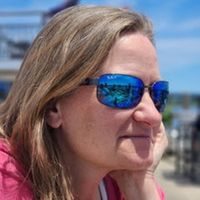
Melanie Griffiths
Lives are busy and time is short. From taking the kids to soccer practice to work commitments and everything in between, there’s little time and energy to deadhead spent blooms and care for persnickety perennials. You want plant-and-forget-it varieties to keep your gardening workload to a minimum.
Growing a beautiful, low-maintenance garden is indeed possible, and plenty of garden types are available to you, such as shade gardens, drought-tolerant gardens, those offering seasonal splendor, and gardens that support pollinators and wildlife.
The thing to know about low-maintenance gardens is that they are not no-maintenance gardens. Occasional weeding helps keep the garden looking good, and the biannual garden cleanups will keep pest and disease pressures low.
There are a few general caveats to any new garden adventure, and those are to use plants suited for your USDA hardiness zone and that are appropriate for your existing light, soil type, and moisture conditions.
To help you on your way, we’ve put together five garden recipes that’ll create the low-maintenance garden you’re looking for.
1. Grasses for Textures and Movement

Ornamental grasses add height, texture, movement, and contrast to a garden, and are as low maintenance as it gets. They also provide food and nesting materials for birds.
- Chinese Silver Grass (Miscanthus sinensis)
This species has numerous varieties, many of which are variegated. They form dense clumps of upward-arching stems about 3 to 4 feet tall with puffy plumes rising several feet higher in late summer. It’s an excellent back-of-the-border or specimen plant. USDA zones 4-9. - Blue Grama Grass ‘Blonde Ambition’ (Bouteloua gracilis)
This 3-foot-tall cultivar has thin, blue-green foliage that produces small, comb-like, blonde-colored seed heads held horizontally on each stem’s peak in late summer. USDA zones 4-9. - Blue Fescue (Festuca glauca)
This steel-gray grass is very dense and rounded and grows to just 12 inches high. Late-season blooms are beige, contrasting nicely with semi-evergreen blue stems. Use it to edge a border or to fill in a bed. USDA zones 4-11. - Dwarf Mondo Grass (Ophiopogon japonicus)
A true front-of-the-border plant at just 4 to 6 inches tall, this grass also adds a dark green, slightly wider foliage contrast to others in a grassy garden. USDA zones 6-11.
2. Shady Situations
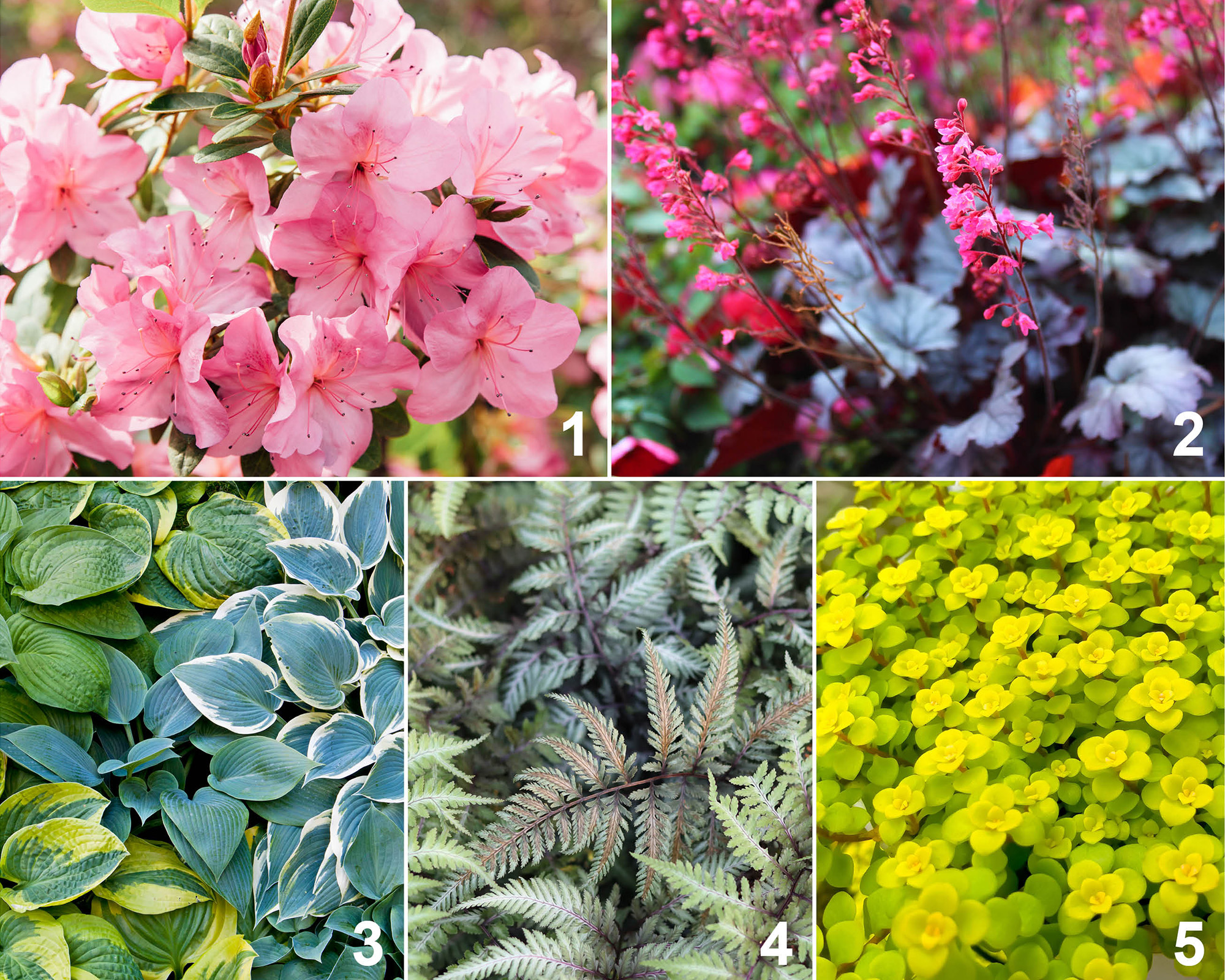
Shady spots beg to be enlivened with the color and texture. Keeping that garden low maintenance means more time for you to enjoy sunnier spots.
Sign up for the Gardening Know How newsletter today and receive a free copy of our e-book "How to Grow Delicious Tomatoes".
- Azalea (Rhododendron spp.)
These woodland natives have spawned numerous cultivars available in a rainbow of colors. New hybrids rebloom their funnel-shaped flowers from spring through fall. USDA zones 5-9. - Coral Bells (Heuchera spp.)
Coral bells are low-mounding plants with semi-evergreen foliage in varying shades of green, peach, purple, red, and more. Insignificant flowers appear on tall stems in spring. USDA zones 4-9. - Hosta (Hosta spp.)
These 1-to-3-foot-tall perennials grown for their foliage come in hundreds of sizes and leaf colors, shapes, and textures, all of which grow well in shade. Variegated forms lighten dark spaces. USDA zones 3-8. - Japanese Painted Fern (Athyrium niponicum)
This fern is special for its range of colors – greens, purples, blues, and silvers – looking as though the colors were painted on. Their 18-to-24-inch fronds fan out to fill the shade. USDA zones 3-8. - Yellow Creeping Jenny (Lysimachia nummularia)
This forms a golden and glowing chartreuse ground cover, bringing a much-needed bright color to shaded spaces. USDA zones 4-9.
3. Leave it to the Leaves
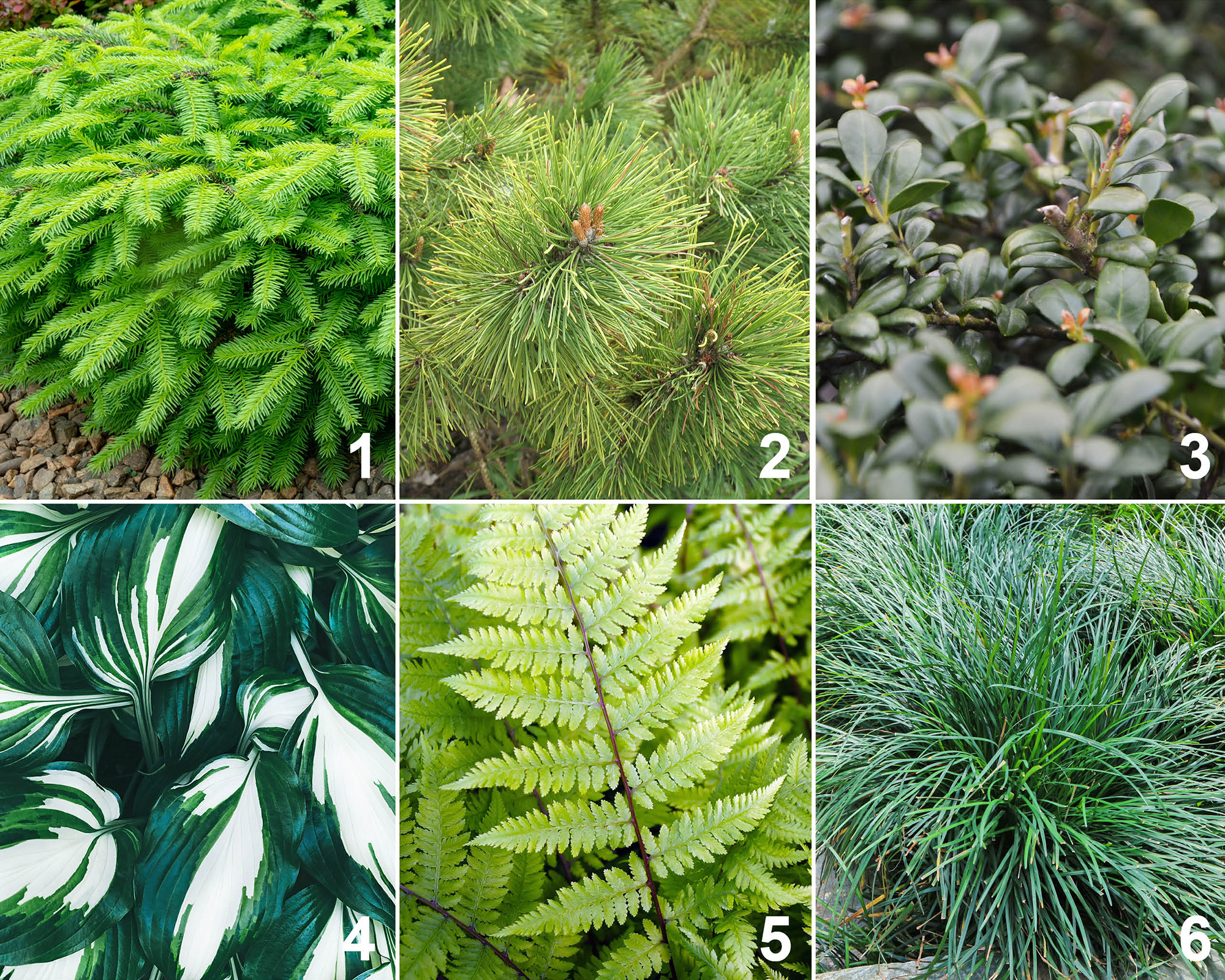
With no dead blooms to snip away, leaves and branches are the stars of a low-maintenance garden. The Medium Foliage Garden Kit by Plant By Number, available to purchase in the Gardening Know How Shop, provides six different plants that will add color, texture, movement, and beauty to any space.
The kit includes a 5-foot by 7-foot planting plan on fabric, and the following plants appropriate for a part-sun garden in USDA zones 5-8:
- Norway Spruce ‘Little Gem’ (Picea abies)
This small-needled, compact evergreen provides year-round structure to the garden. - Dwarf Mugo Pine 'Slowmound' (Pinus mugo)
Another evergreen, this has a naturally rounded shape with candle-like cones. - Japanese Holly ‘Soft Touch’ (Ilex crenata)
This holly is known for its soft and dense evergreen foliage. - Hosta ‘Fire and Ice’ (Hosta spp.)
The wide splash of white in the center of each green-edged leaf gives the illusion of spiraling movement down the midrib. Captivating! - Lady Fern ‘Lady In Red’ (Athyrium filix-femina)
Its lush mid-green fronds are made more vibrant with a dark-red stem. - Dwarf Mondo Grass (Ophiopogon japonicus)
With its compact, grass-like leaves, dwarf mondo grass is an excellent choice as an evergreen ground cover.
4. Hands-off Succulents for Containers
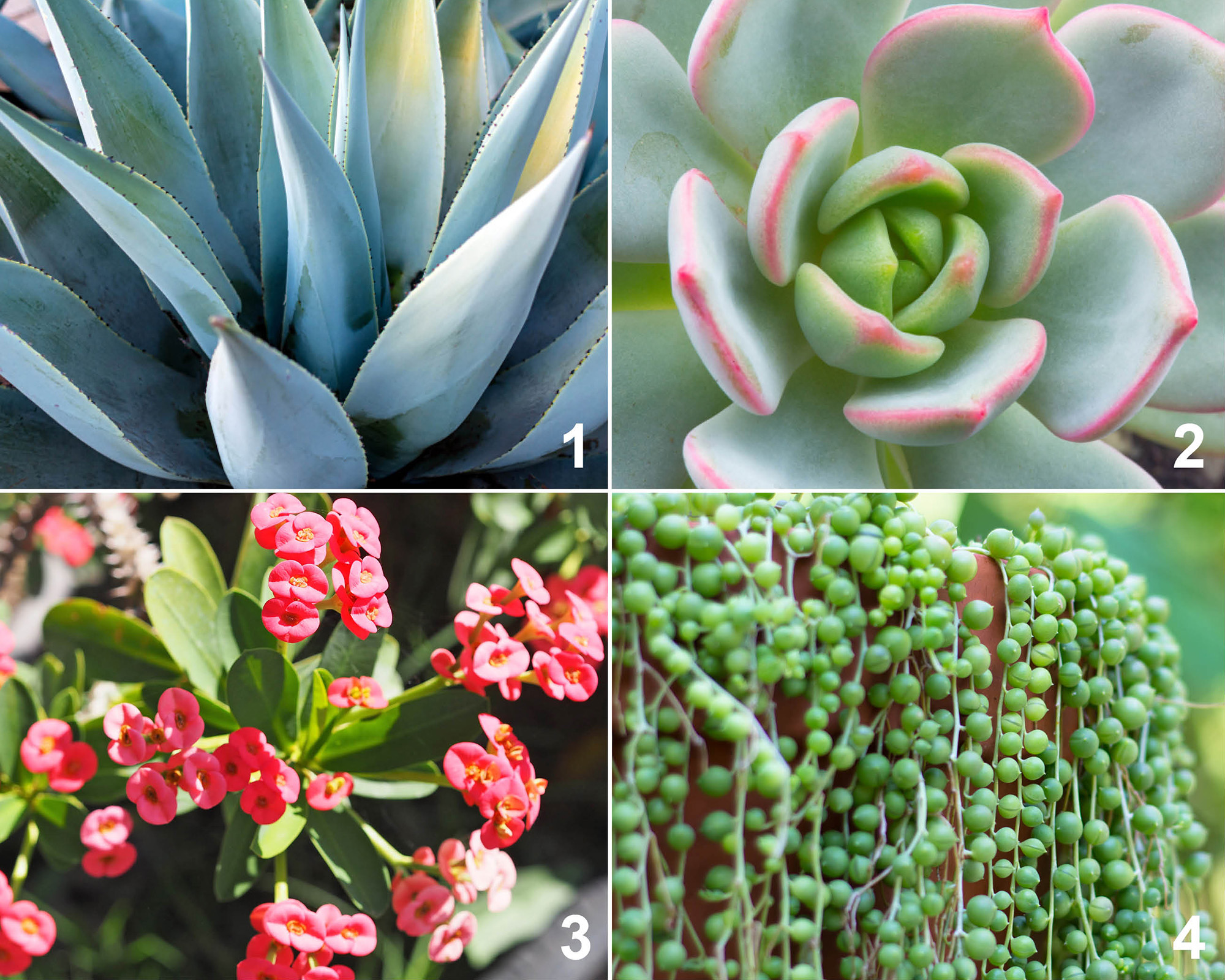
Use succulents and cacti in containers to bring color, texture, and life to your outdoor entertaining spaces with minimal effort. Plant larger varieties individually as specimen plants. Note: Most are not cold-hardy and must be protected in winter.
- Agave (Agave spp.)
Agave’s thick, toothed blue-green leaves are architecturally stunning. Available in a range of sizes, go for the larger size to use as a statement plant. USDA zones 8-10. - Echeveria (Echeveria spp.)
All echeveria varieties are drought-tolerant, easy to grow, and typically just under 1 foot tall. Each chubby, pointy-tipped leaf begins bluish and turns various colors depending on the variety. These rosette-shaped plants form clumps of many individuals over time. USDA zones 9-10. - Crown of Thorns (Euphorbia milii)
While this subtropical succulent has sharp thorns as the name suggests, its simple small flowers are cheerful in colors of red, orange, pink, and yellow. Grows 3 to 6 feet tall. USDA zones 9-11. - String of Pearls (Curio rowleyanus)
Pearls is just one of many “string of” plants that cascade with interestingly shaped succulent leaves. Use these as a “spiller” in your succulent container garden. USDA zones 10-11.
5. Bird-Friendly Favorites
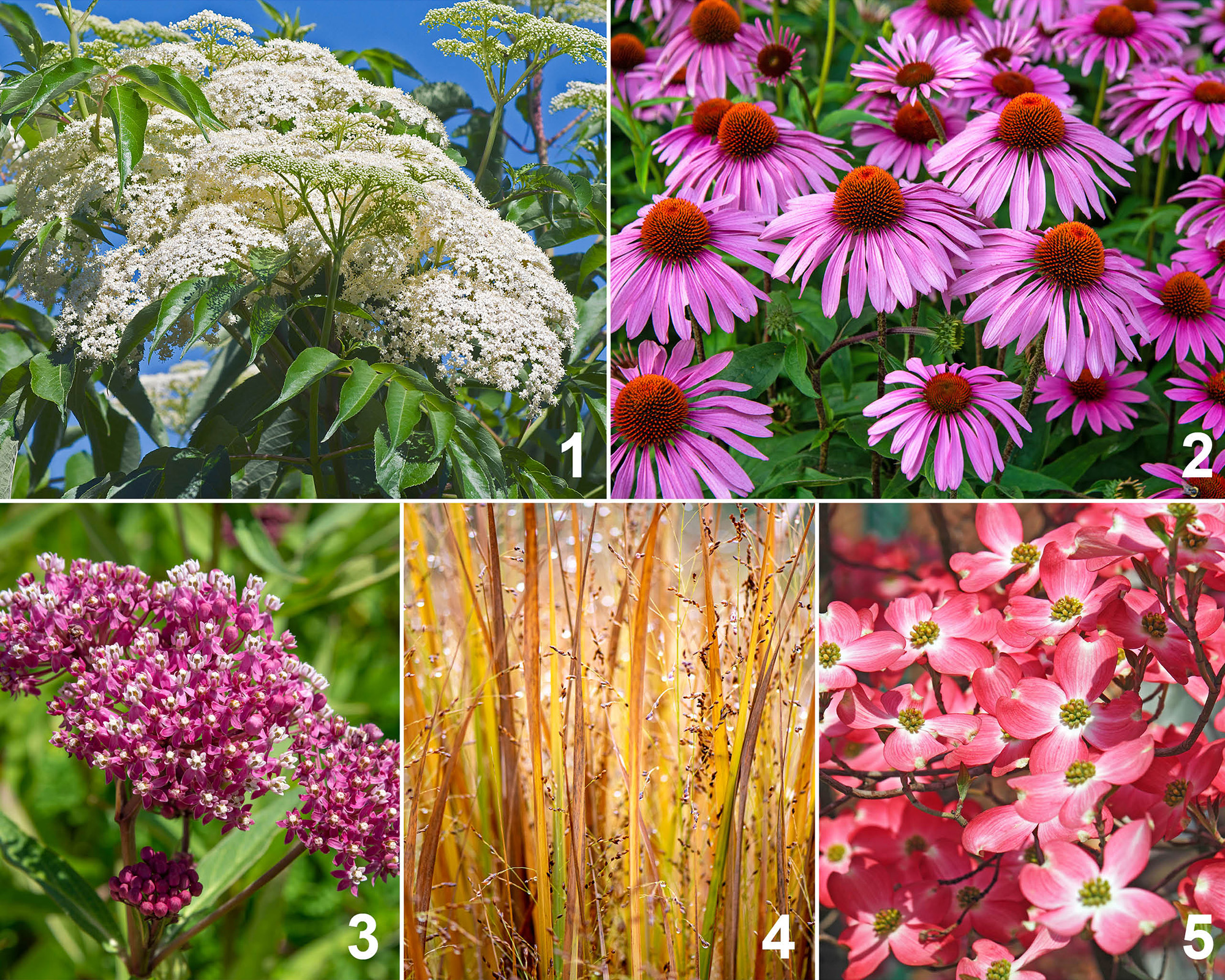
Many bird-friendly shrubs and perennials are just as low maintenance as grasses or succulents. Keep the berries and dry seedheads for birds to forage through winter.
- Wild Elderberry (Sambucus canadensis)
This 8-to-10-foot shrub blooms with cream-colored flowers in summer, producing a bounty of black, nutrient-packed fruits for birds. Its fall foliage is a deep dark red. USDA zones 3-9. - Coneflower (Echinacea purpurea)
Large, cone-shaped flowers come in numerous colors. As the seeds mature, the sturdy stems provide stable landing spots for birds to sit and feast. USDA zones 4-8. - Milkweed (Asclepias spp.)
Better known for its benefits to monarchs, birds are drawn to milkweed because it attracts insects and provides nesting material. USDA zones 3-10. - Switchgrass (Panicum virgatum)
The 6-foot-tall native prairie grass produces loads of seeds, which songbirds and others eat once fallen. Several varieties turn shades of red in fall. Check for invasiveness in your region. USDA zones 5-9. - Dogwood (Cornus spp.)
Birds love to eat a dogwood’s fruit. Several species that grow from 15 to 40 feet tall are native to the US, so choose the one local to your region. USDA zones 5-9.
This article features products available from third-party vendors on the Gardening Know How Shop.
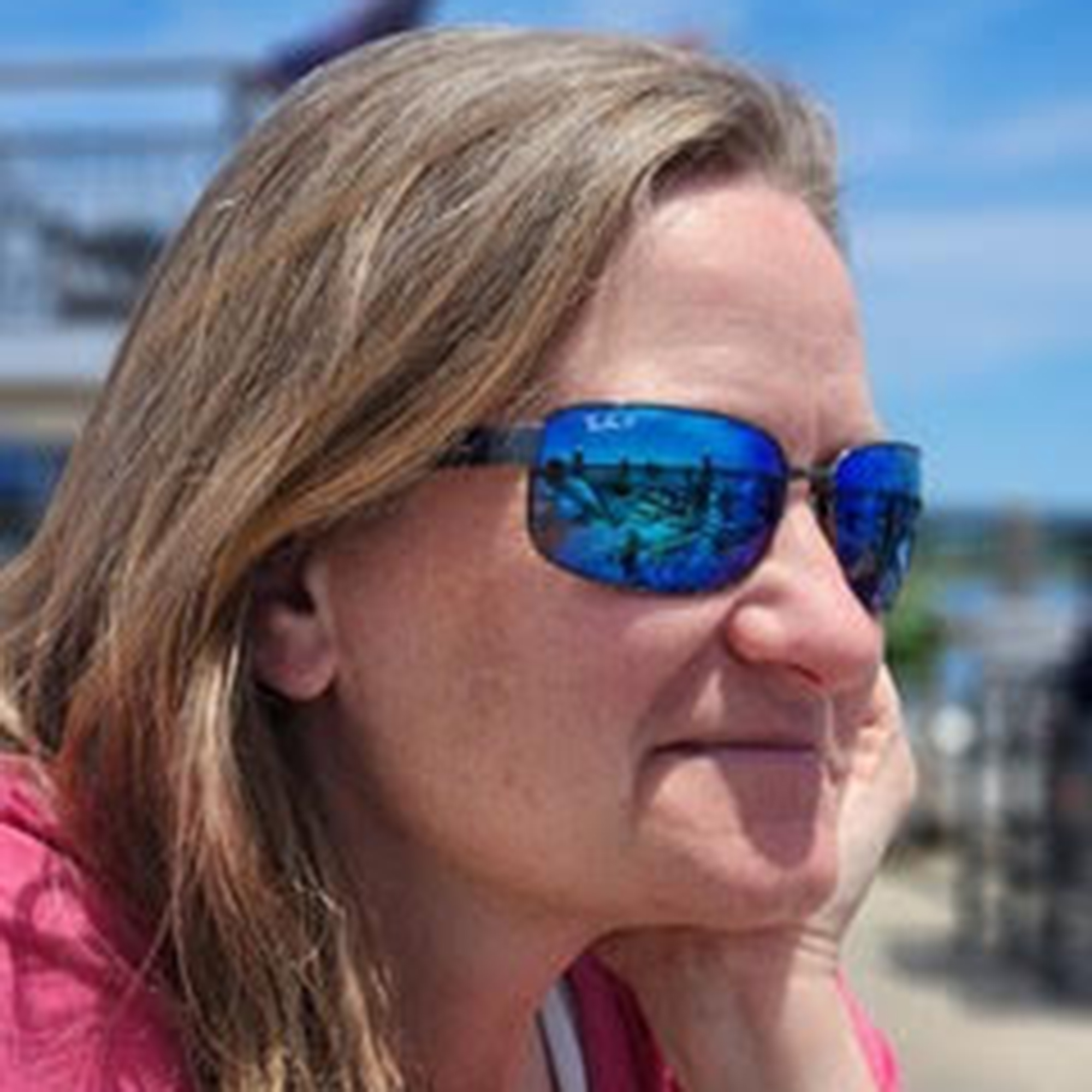
Ellen Wells is a horticultural communications consultant with 30 years of experience writing about all aspects of the gardening world.
She has worked for many of horticulture’s biggest brand names, writing blog posts, articles, press releases, and design and instructional pieces. Her previous roles include Senior Editor and Editor-at-Large for Ball Publishing.
Ellen is based in New England where she gardens in Zone 7a. She loves tending to flower-filled containers on the patio and puttering around her vegetable garden.
- Melanie GriffithsEditor in Chief